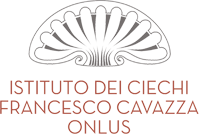On September 3, 5, 10, and 13, 2024, the Cavazza Institute’s Educational Consulting Service held a training course for teachers and tutors to provide basic skills in reading and writing Braille and on the main functions of tifloinformatic tools. The course was organized in two modules, each with two lessons, taught by engineer Giovanni Cellucci and by Paola Gamberini, Martina Belvisi, and Francesca Indelicato, three staff members of the Educational Consulting Service.
The course was designed specifically to facilitate a number of blind or seriously sight-impaired children (followed by the service) in their difficult transition from elementary to middle school.
The Educational Consulting Service has always followed these moments of change with particular attention, because they often create anxiety and worry for families as well as for new school teams, who are confused by the prospect of having to receive a seriously sight-impaired student without having specific skills.
Acquiring basic knowledge of Braille and of the operation and use of assistive technologies for learning is an essential first step for starting the new school year with greater confidence, motivation, and preparation.
The participants learned the structure and functioning of Braille as well as the difference between traditional 6-dot Braille and the 8-dot Braille used in tifloinformatics. They also did exercises in reading and writing with a Braille writer. Although they won’t be asked to teach Braille to their future students (who have already learned this in elementary school), this basic training will allow them to follow these students more effectively and have a much better understanding of their difficulties and errors.
The tifloinformatics module first described the working of screenreaders and their two output modes: vocal (by means of speech synthesis) and Braille (by means of Braille display). The module then illustrated the main keyboard commands of the NVDA (Non visual desktop access) screenreader, of Windows, and of Word, selecting the most appropriate ones for editing and file management. The main and most often used commands on Braille displays were also specified.
The course was designed with a strictly didactic approach, and therefore the presentation of technical details was always accompanied by an illustration of their use and their role in the student’s learning process. The course also explained the precise steps to be followed to make blind students’ initial use of new technologies as gradual and systematic as possible.
We are very satisfied with the success of this course, attended by over 30 teachers from all over the region, and have already received positive feedback on its application in daily teaching experiences. An excellent premise for repeating the course in the future and for making it an integral part of the Educational Consulting Service’s proposal.

.jpg)



.png)